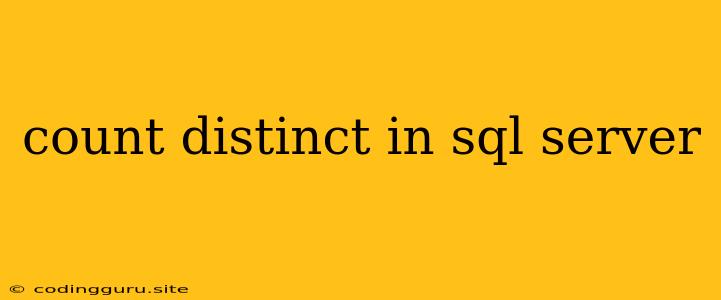Understanding COUNT DISTINCT in SQL Server
In the realm of database management, SQL Server plays a pivotal role in extracting valuable insights from vast amounts of data. One crucial aspect of this process involves understanding and utilizing the COUNT DISTINCT function effectively. This function allows you to count the number of unique values within a specific column of your database table.
Imagine a scenario where you need to analyze a customer database and determine the distinct number of cities from which your customers originate. This is where COUNT DISTINCT comes into play.
Syntax of COUNT DISTINCT
The syntax for using COUNT DISTINCT in SQL Server is straightforward:
SELECT COUNT(DISTINCT column_name)
FROM table_name
WHERE condition;
Let's break down the syntax:
- SELECT COUNT(DISTINCT column_name): This specifies that you want to count the distinct values within the specified
column_name. - FROM table_name: This indicates the table from which you want to retrieve data.
- WHERE condition: (Optional) This allows you to filter the data based on a specific condition.
Example
Let's consider a table named Customers with the following columns:
CustomerIDCustomerNameCity
To count the number of distinct cities in the Customers table, you would use the following query:
SELECT COUNT(DISTINCT City) AS DistinctCities
FROM Customers;
This query would return a single value representing the number of unique cities in the Customers table.
Benefits of Using COUNT DISTINCT
- Accurate Data Analysis: COUNT DISTINCT helps provide precise counts of unique values, which is essential for accurate data analysis and reporting.
- Data Deduplication: It eliminates duplicate entries from your count, ensuring that you are working with distinct values only.
- Performance Optimization: COUNT DISTINCT can be optimized for performance by using appropriate indexing strategies.
Common Use Cases
- Customer Segmentation: Determining the distinct number of customers in specific geographical regions or with particular buying habits.
- Product Analysis: Counting the unique number of products sold in a specific period or by different customer groups.
- Website Analytics: Analyzing the unique number of visitors to a website or the distinct number of pages viewed.
Alternatives to COUNT DISTINCT
While COUNT DISTINCT is a powerful function, there are situations where alternative approaches might be more suitable. Some alternatives include:
- GROUP BY: Using the
GROUP BYclause in conjunction withCOUNT(*)can achieve similar results, especially when you need to group data based on multiple criteria. - DISTINCT Clause: The
DISTINCTclause can be used with other aggregate functions likeSUM(),AVG(),MIN(), andMAX().
Conclusion
COUNT DISTINCT is an indispensable tool for data analysis in SQL Server, enabling you to efficiently count the number of distinct values in a column. By understanding its syntax, benefits, and common use cases, you can leverage this function to extract valuable insights from your data and make informed decisions.
